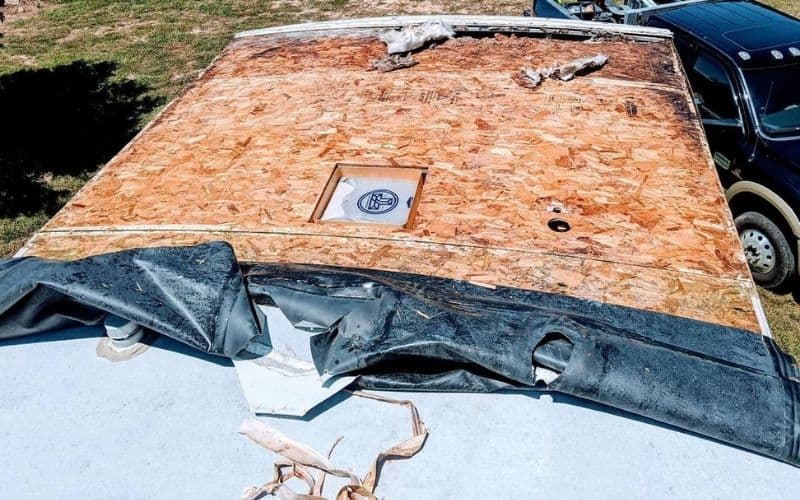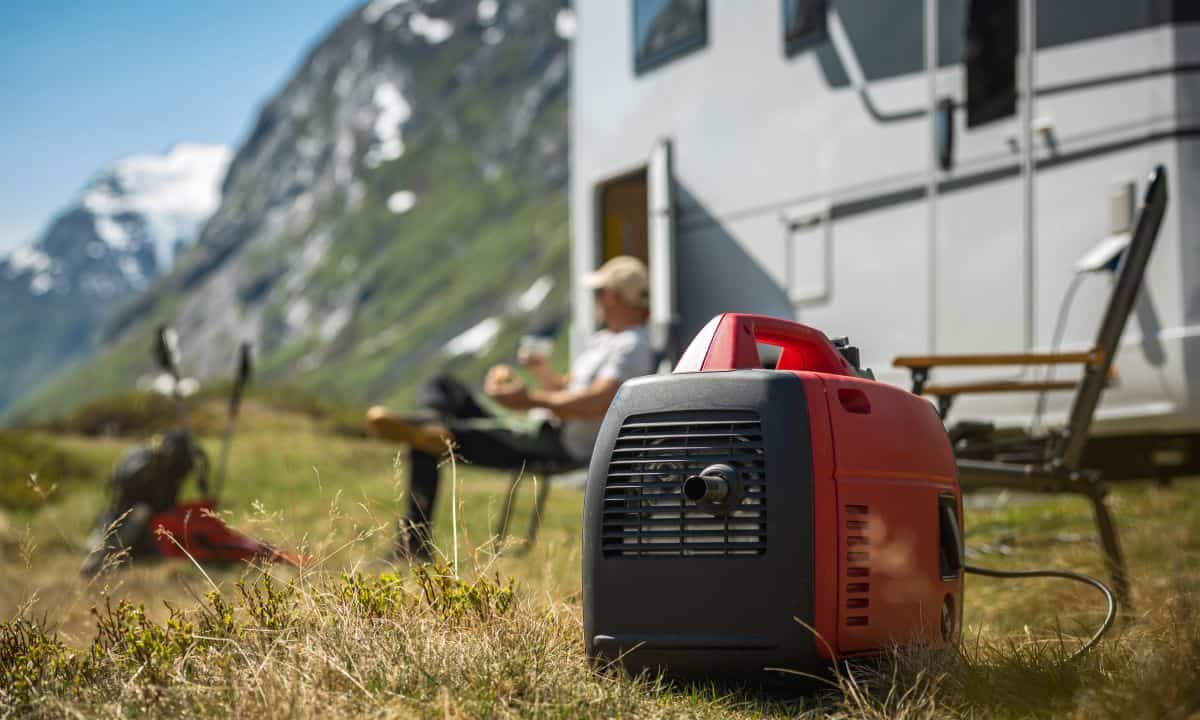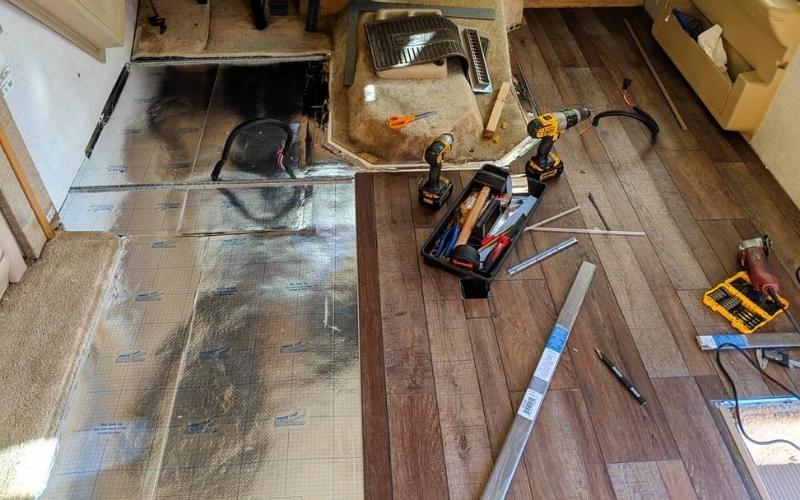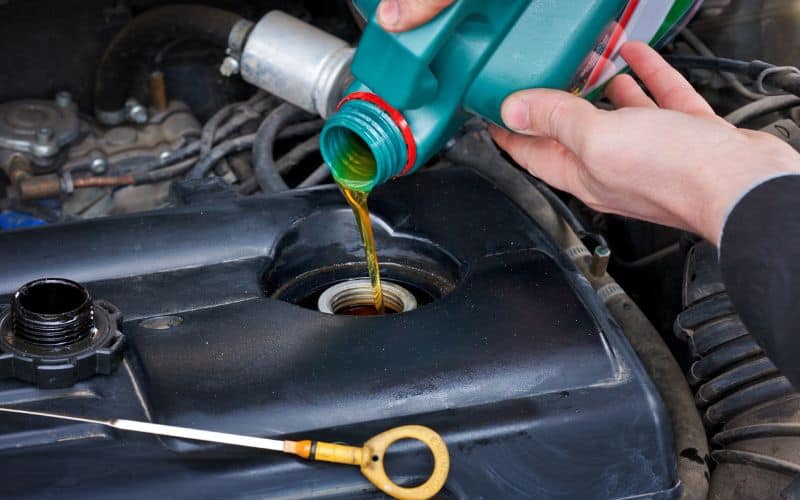Being able to extend your RV roof’s lifespan by maintaining the roof is a critical component of maximizing its value.
This can include things like making sure to keep your roof clean and repairing roof leaks as soon as possible.
Though there is no one single type of RV roofing material. Finding the right one to repair or replace your RV’s roof takes a little insight.
Since RVs first became popular in the late 1950s there have been generations of material used on the roofs of most RV models: EPDM, TPO, and Superflex.
All three are distinct in their appearance, so it isn’t too difficult to tell which kind of material your RV has if you know where to look.
What Are The Most Common Types Of RV Roof Material?
RV roofing materials have changed over the years. There are also different types of RV and different manufacturers who use different roofing materials throughout their model line.
We decided to get on top of the most common RV roof materials to better understand their strengths and weaknesses as well as the ways you might repair a simple roof leak.
1. Rubber EPDM
The technical term for this special type of rubber is “Ethylene Propylene Diene Monomer.”
It is essentially a special type of rubber membrane that used to be used to cover flat-roofed RVs.
Rubber EPDM is relatively inexpensive and is sometimes used to skin an RV roof that has multiple roof leaks that cannot be easily repaired.
What Are The Strengths of a Rubber EPDM RV Roof?
Rubber EPDM is relatively lightweight, which makes it easy to use them to skin an RV with multiple roof leaks, without adding a lot of extra weight to the equation. It is also very durable and won’t scratch or tear easily.
What Are The Weaknesses of a Rubber EPDM RV Roof?
A lot of people complain about the aesthetics of a rubber EPDM roof on an RV. It basically looks like a sheet of black rubber innertube.
Of course, the dark color also means that it tends to heat up in the direct sun, which can be an issue if you are trying to keep your RV cool on a hot summer day.
While a rubber EPDM RV roof is scratch and tear-resistant, punctures can be a real problem.
Even something as simple as backing into a sturdy tree branch with a sharp point can poke a hole in the polymerized rubber.
This can lead to a frustrating roof leak with water trapped between the sheet of black rubber and the underlying roof structure.
How To Repair A Rubber EPDM RV Roof?
Small punctures and minor rubs in a Rubber EPDM roof can be easily repaired by applying a liquid roof membrane adhesive and a small rubber shingle that serves as a patch.
If the damaged section is more than 12 to 16 inches long, you might have to consider completely replacing the rubber EPDM membrane from scratch.
2. Rubber TPO
This is another type of polymerized rubber that is stretched out into a single ply. Two different types of Rubber TPO have been used over the years.
Though both Polypropylene and Ethylene-Propylene have fortified durability chemically infused into them.
What Are The Strengths of a Rubber TPO RV Roof?
There are a few benefits of using a rubber TPO for an RV roof. For starters it is white, so it doesn’t absorb heat the way that a rubber EPDM RV roof membrane does.
It is also easy to install and has an almost cloth-like feeling. It can be installed with special adhesives or even electrically welded to seal it around rooftop structures like a rooftop air conditioner.
What Are The Weaknesses of a Rubber TPO RV Roof?
There isn’t consistent quality control through this manufacturing segment. So, you will have to read through a lot of reviews to find the best rubber TPO fabric.
You need to prioritize a thicker material if you want to heat weld it. Also, prioritize a manufacturer who ships it rolled instead of folded.
A folded sheet or rubber TPO will still have noticeable creases when installed.
Rubber TPO can be prone to cracking as time goes on. To maximize the life of this RV roofing material, you need to be diligent about storing it indoors or under a covered structure to prevent photodegradation and cracking caused by the freeze-thaw effect of seasonal transitions.
How To Repair A Rubber TPO RV Roof?
If you have thicker commercial-grade rubber TPO for your RV roof you can simply buy a patch and then head weld it over the compromised section.
As long as you are careful with making sure all the seams are fully sealed, it should fully restore the waterproof integrity of your RV’s roof.
3. Fiberglass
Fiberglass is essentially miniscule strands of glass that are bonded together in a special type of plastic resin.
This makes a tough shell that can also be molded into rounded shapes. Though it can crack with time and can be severely compromised by a modest collision.
What Are The Strengths of a Fiberglass RV Roof?
Fiberglass has a reputation for durability, which reduces the risk of cracks and damage from minor dings and collisions.
It is also completely rustproof and very fire-resistant. It can also be molded into creative shapes, colors, and patterns.
Another great benefit to a fiberglass RV roof is that it has superior insulative qualities to get the most out of your air conditioner or heater regardless of what the outside weather throws at you.
What Are The Weaknesses of a Fiberglass RF Roof?
While fiberglass RV roofing is very durable, it can be cracked with a strong collision, and the repairs can be expensive.
Extreme heat with direct sun can potentially cause thermal splits and cracks in an RV’s fiberglass roof.
So, even though it offers superior insulation value for the interior of the RV, it’s still best to always park it in a shady spot when camping, and summer storage.
How To Repair A Fiberglass RV Roof
Fiberglass repair kits are sold at most big box hardware stores. If you closely follow the directions, you can address most chips and minor cracks before they worsen.
Though more severe damage, usually require professional repair.
Sometimes it is more cost-effective to have an entire section of fiberglass RV roof replaced rather than repaired.
If neither of these options is feasible for your budget, you might want to consider reskinning the damaged RV fiberglass roof with Rubber EPDM or commercial-grade Rubber TPO.
When properly applied, these thin membranes can restore the waterproof quality of your RV’s roof, while still maintaining the structure of the fiberglass.
4. Aluminum roof
Aluminum sheeting has taken over as one of the preferred roof materials for many RV manufacturers. It is lightweight and rigid.
Aluminum can also be overlapped and sealed for superior waterproofing.
Though there are a few things that you need to take into consideration before you choose aluminum for your RV roofing material.
What Are the Strengths of an Aluminum RV Roof?
Aluminum is lightweight and durable, which makes it one of the best RV roofing materials.
At the same time, aluminum sheeting is less likely to be pierced or punctured by overhead tree limbs, which is something you will appreciate if you like to camp in primitive forest campgrounds.
Of course, since it is a type of metal, aluminum is also more fire-resistant.
What Are the Weaknesses of an Aluminum RV Roof?
One of the biggest drawbacks about aluminum as an RV roofing material is its penchant for suffering sea failures where two sheets meet.
This is even more likely to be an issue if you frequently take your RV on rough bumping roads.
This can lead to annoying roof leaks early in an RVs life. It’s also worth bearing in mind that since it is metal, aluminum is not heat resistant, and can affect the interior of your RV on a hot and sunny day. Aluminum RV roofs can also be frustrating to repair.
How To Repair an Aluminum RV Roof
The aluminum sheeting used for RV roofs can be difficult to repair as it doesn’t bond well, even with strong adhesives.
Your best option is to use physical fasteners like galvanized self-tapping sheet metal screws and aluminum sheeting to create a “Patch” over a failed seam or damaged section.
Which Kind Of RV Roof Material Is The Best For Your Camper
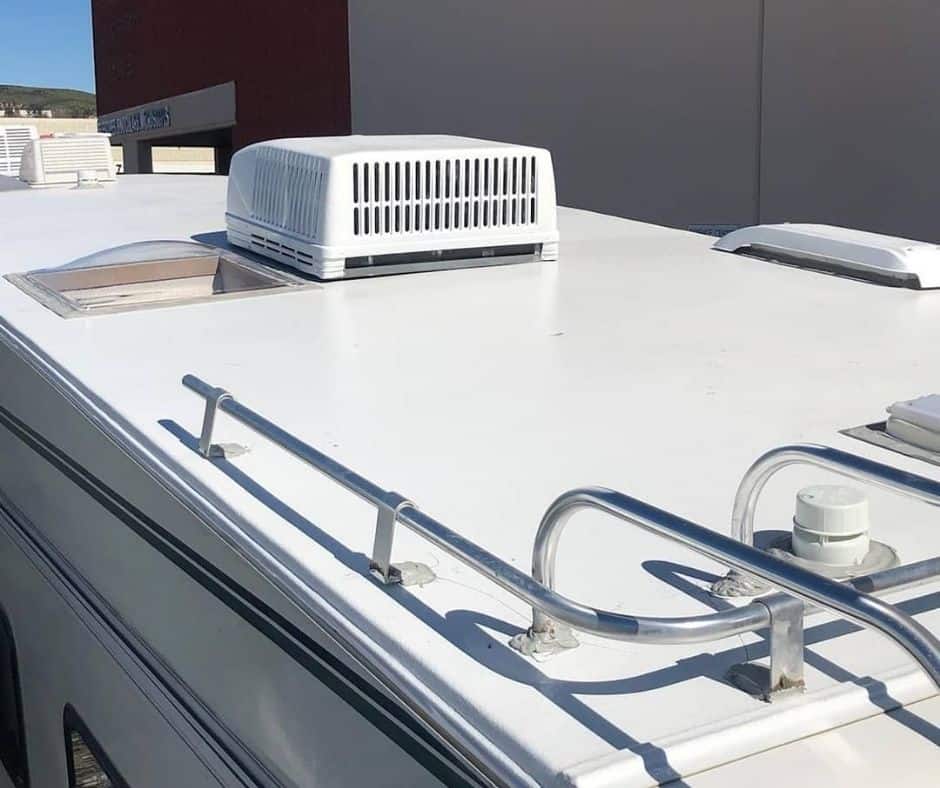
If you are thinking about repairing or replacing the roof of your RV, it might help to compare the different RV roofing materials side by side.
TPO vs EPDM RV Roof: Which One Should You Use?
There are a lot of similarities between Rubber TPO and Rubber EPDM for RV roofing materials.
Rubber EPDM | Rubber TPO | |
Usage | Used for 60 years | Used for around 20 years |
Sunlight Exposure | Retains sunlight & heat | Reflects sunlight & heat |
Cost | Low | Medium-low |
Color | Black | White, gray, or tan |
Attachment | Tape fused seams | Seams welded by hot air gun |
Repair | Easy | Moderate |
Lifespan | 20 to 25 years | 15 to 20 years |
Choosing Between Fiberglass & Aluminum RV Roof
A lot of people who are replacing, repairing, or choosing a structural roof for their RV debate between going with a fiberglass shell or aluminum sheeting.
Fiberglass | Aluminum Sheeting | |
Usage | Used for 60 years | Used for around 20 years |
Sunlight Exposure | Insulative effect for RV interior | Absorbs heat |
Cost | Medium | Medium |
Color | Varies | Varies |
Attachment | Molded and adhesive | Physical fasteners |
Repair | Challenging | Moderate |
Lifespan | Up to 40 years | 20 years or more |
Conclusion
If you are thinking about buying a new RV or replacing the roof on an existing RV, your choice of best RV roof material is largely depends on your personal preference.
When it comes to a new RV, most current models that you will find in a dealership will come with aluminum sheeting or fiberglass roofs.
Of these two options aluminum sheeting is more common, and lighter, which can be a factor if you are going to be towing a travel trailer.
Though there are some all-fiberglass RVs like the scamp, which are made to be as lightweight and aerodynamic as possible.
When it comes to repairing or replacing an older RV roof, your material selections become more versatile.
If your existing RV roof has a frustrating water leak or two, it might be easier to reskin the top with a membrane of rubber EPDM or rubber TPO than it is to completely replace the entire RV roof.
This sort of fix lets you leave all the underlying structure of the roof in place while restoring the waterproofing.
All at a cost that won’t break your budget. It is a common solution used on a lot of older small travel trailers and popup campers.

